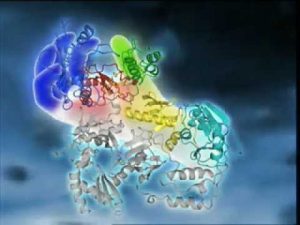Watch more How to Understand Obesity videos: http://www.howcast.com/videos/511330-How-the-Body-Stores-Fat-Obesity When you eat food, all food has calories. Calorie is a unit of energy, so when you eat food digestion begins in your stomach and then your intestines, and your body absorbs the nutrients that it needs in to your bloodstream. Throughout the day, your body will use those calories to help everyday functions of your heart, your lung, your brain, and even just going about your daily life. Whatever excess calories are not used can then be stored as fat. One place that the body stores fat is in your liver. So if you’ve ever had an ultrasound or a CAT scan, someone might have told you that you have a fatty liver. Another place that your body stores fat is just centrally, in your abdomen. This is called the omentum, that’s the fat that encases our organs. We all have that, but people have different amounts of fat depending on how much weight they’re carrying, and that’s actually the dangerous kind of fat, the kind that’s found centrally. Other people store their fat, maybe lower in their bodies, in their hips, in their thighs. This is referred to as gynecoid obesity. So while there’s different ways that the body stores fat, in order to determine if the amount of fat that you’re storing is excessive and that it puts you at increased health risk, you might want to calculate your BMI or your body mass index. And that’s the number that takes your weight and your height and forms a ratio, and helps you decide if you fall in to the obese category. A BMI of 30 or greater is considered obese and puts you at increased health risks. So these are just a few ways of how your body stores excess fat.

How the Body Stores Fat | Obesity
- Post author:
- Post published:May 27, 2021
- Post category:Uncategorized
- Post comments:0 Comments
You Might Also Like

What is Fitness Empowerment by Danye? Trailer / Why I do what I do!

FAT LOSS 101 FOR MEN (Chest Fat, Belly, Love Handles!)

What blood test shows kidney function ?

Hyperextension With Machine-1

Grow Taller Exercises: Top 10 Best Stretching Exercises to Increase Height & Get or Grow Taller

How do fertility drugs work? – Dr. Sangeeta Gomes

RI MMA Q & A – (Pre-workout Preparation Essentials)

Mode of action of NNRTIs

Now omega-3 review (100 soft gel) | omega-3 kya hota h | omega-3 fish oil work | fish oil benefits |

Anabolic Steroids – History, Definition, Use & Abuse Video – 12

Vitamin B7 | Deficiency | Biotin | Hair fall | MudeserAliFitnessPro | Nutritionist

Curcumin Plus Silymarin Could become a Powerful Cancer Fighting Combo

Patient Education Video: Low Testosterone

Single Arm Dumbbell Row – HASfit Back Exercise Demonstration – One Dumbbell Row – Supported Row
Anaerobic

Bench Press – 5 Biggest Bench Press Mistakes

Exercise vs Diet

Omega 3 Fatty Acids के फायदे और नुकसान – Wow, Amway, Healthkart, MuscleBlaze, Healthviva Review

Sports Medicine Video – 4

Elements of the Human Body

General Surgery Video – 2

How to Do a Swiss Ball Seated Curl | Arm Workout

How to Do Reverse Hypers with a Swiss Ball

Side Effects of Valium

Meditation Video – 1

Digestive System And Asnas Video – 2

What to Expect With Orlistat – Weight Loss Medications

What is ANEMIA? What does ANEMIA mean? ANEMIA signs, symptoms, causes & treatment

Leg Extension-6

Dr. Jason Fung: To Lose Weight, You MUST control Insulin

What is Arthritis? – Arthritis Types and Basic Information – Dr. Rakesh Aggarwal – Tell Me Doctor

Special Weight Loss Routine Video – 1

B3: Diabetes (Revision)

The Best Science-Based Leg Workout for Growth (Glutes/Quads/Hams)

what is diabetes type 2?

Physiotherapy in Obstetrics Video – 13

Lower Ab Exercise Mistakes (REVERSE CRUNCH!)

Past Life Regression Video – 1

Overweight & Obesity Video – 16

How Does a CT Scan Work?

Can A Brain Injury Make You A Genius?

